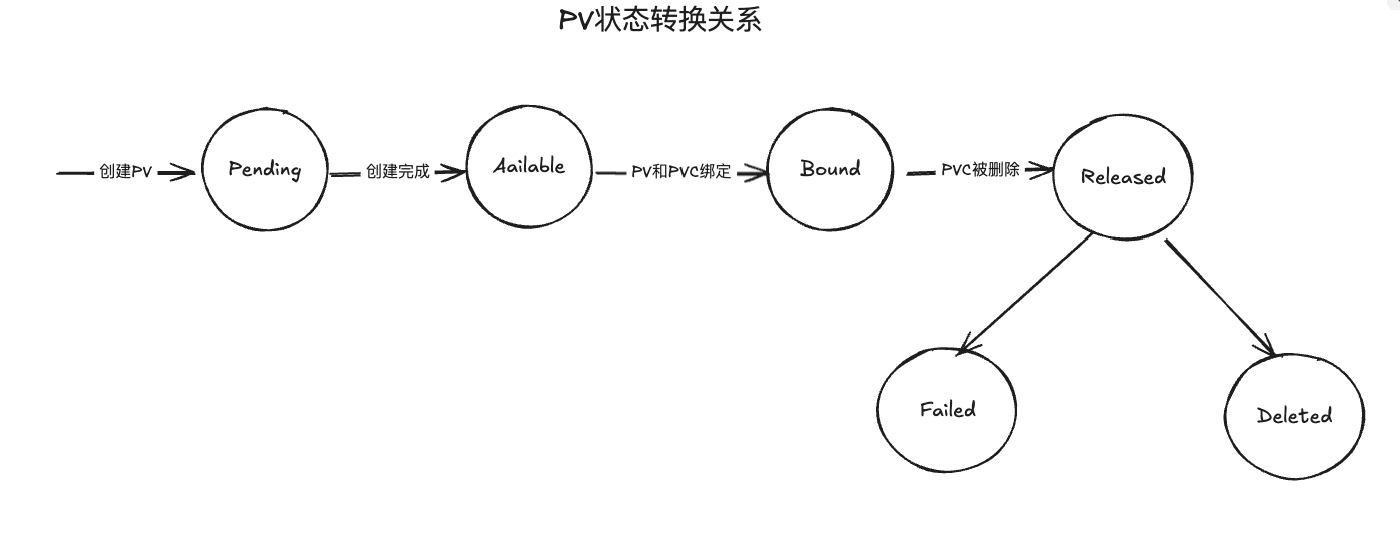K8s核心资源对象-配置和存储资源
K8s核心资源对象-配置和存储资源
基于1.25
卷
什么是卷
容器中的文件在磁盘上是临时存放,Pod重启数据可能就会消息,卷就是为了实现持久化而出现
卷的类型
emptyDir卷
当Pod被分配到某个节点上的时候,emptyDir卷会被创建
- Pod在节点运行中,emptyDir卷一直存在
- emptyDir卷最初是空的
- emptyDir卷在Pod在该节点被删除之后,也会消失
hostPath卷
能把主机节点系统上的文件目录挂载到Pod
configMap卷
提供向Pod注入ConfigMap的方法
- ConfigMap对象中存储的数据可以被ConfigMap卷引用,之后被Pod中运行的容器化应用使用
downwardAPI卷
为应用服务器提供DownwardAPI数据
- 允许容器在不使用K8s客户端的情况下,获得到自己或者集群的信息
secret卷
用来给Pod传递一些敏感的信息
- 可以通过文件的形式挂到Pod中
nfs卷
把NFS挂到Pod中
- nfs数据不会随着Pod消减,而消减
cephfs卷
允许把现存的cephfs卷挂载到Pod中
- cephfs卷数据不随着Pod消减,而消减
persistentVolumeCliam卷
用来给持久卷(PV)挂载到Pod中
- 不会随着Pod消减,而消减
卷的状态
- Available:可用,空闲资源,等待使用
- Bound:已经绑定,卷已经被某处使用
- Released:已经释放,绑定消失,还没有被集群回收
- Failed:失败,卷的自动回收操作失败
PV和PVC
什么是PV和PVC
PV是集群中的一块存储资源
PVC是对集群存储资源的申请
PersistentVolumeSpec
// PersistentVolumeSpec is the specification of a persistent volume. |
PersistentVolumeClaimSpec
-
// PersistentVolumeClaimSpec describes the common attributes of storage devices
// and allows a Source for provider-specific attributes
type PersistentVolumeClaimSpec struct {
// accessModes contains the desired access modes the volume should have.
// More info: https://kubernetes.io/docs/concepts/storage/persistent-volumes#access-modes-1
// +optional
// 访问模式
AccessModes []PersistentVolumeAccessMode `json:"accessModes,omitempty" protobuf:"bytes,1,rep,name=accessModes,casttype=PersistentVolumeAccessMode"`
// selector is a label query over volumes to consider for binding.
// +optional
// 选择绑定的卷
Selector *metav1.LabelSelector `json:"selector,omitempty" protobuf:"bytes,4,opt,name=selector"`
// resources represents the minimum resources the volume should have.
// If RecoverVolumeExpansionFailure feature is enabled users are allowed to specify resource requirements
// that are lower than previous value but must still be higher than capacity recorded in the
// status field of the claim.
// More info: https://kubernetes.io/docs/concepts/storage/persistent-volumes#resources
// +optional
// 最小资源配置
Resources ResourceRequirements `json:"resources,omitempty" protobuf:"bytes,2,opt,name=resources"`
// volumeName is the binding reference to the PersistentVolume backing this claim.
// +optional
// 与PVC绑定的PV名称
VolumeName string `json:"volumeName,omitempty" protobuf:"bytes,3,opt,name=volumeName"`
// storageClassName is the name of the StorageClass required by the claim.
// More info: https://kubernetes.io/docs/concepts/storage/persistent-volumes#class-1
// +optional
// StorageClass名称
StorageClassName *string `json:"storageClassName,omitempty" protobuf:"bytes,5,opt,name=storageClassName"`
// volumeMode defines what type of volume is required by the claim.
// Value of Filesystem is implied when not included in claim spec.
// +optional
// 同PV的VolumeMode
VolumeMode *PersistentVolumeMode `json:"volumeMode,omitempty" protobuf:"bytes,6,opt,name=volumeMode,casttype=PersistentVolumeMode"`
// dataSource field can be used to specify either:
// * An existing VolumeSnapshot object (snapshot.storage.k8s.io/VolumeSnapshot)
// * An existing PVC (PersistentVolumeClaim)
// If the provisioner or an external controller can support the specified data source,
// it will create a new volume based on the contents of the specified data source.
// If the AnyVolumeDataSource feature gate is enabled, this field will always have
// the same contents as the DataSourceRef field.
// +optional
// 用于实现存储快照
// 只用CSI支持配置
DataSource *TypedLocalObjectReference `json:"dataSource,omitempty" protobuf:"bytes,7,opt,name=dataSource"`
// dataSourceRef specifies the object from which to populate the volume with data, if a non-empty
// volume is desired. This may be any local object from a non-empty API group (non
// core object) or a PersistentVolumeClaim object.
// When this field is specified, volume binding will only succeed if the type of
// the specified object matches some installed volume populator or dynamic
// provisioner.
// This field will replace the functionality of the DataSource field and as such
// if both fields are non-empty, they must have the same value. For backwards
// compatibility, both fields (DataSource and DataSourceRef) will be set to the same
// value automatically if one of them is empty and the other is non-empty.
// There are two important differences between DataSource and DataSourceRef:
// * While DataSource only allows two specific types of objects, DataSourceRef
// allows any non-core object, as well as PersistentVolumeClaim objects.
// * While DataSource ignores disallowed values (dropping them), DataSourceRef
// preserves all values, and generates an error if a disallowed value is
// specified.
// (Beta) Using this field requires the AnyVolumeDataSource feature gate to be enabled.
// +optional
// 指定数据源对象引用
DataSourceRef *TypedLocalObjectReference `json:"dataSourceRef,omitempty" protobuf:"bytes,8,opt,name=dataSourceRef"`
}PV类型
PV使用插件实现,下面是K8s集中常见的实现:
- cephfs:cephfs卷
- csi:容器存储实现接口
- fc:Fibre Channel实现
- hostPath:hostPath单节点使用
- iscsi:iSCSI实现
- local:节点上挂着本地存储设备
- nfs:网络文件系统NFS实现
- rbd:Rados块设备实现
PV访问模式
PV可以使用资源提供者所支持的任何方式到宿主系统上
访问模式有以下几种:
- ReadWriteOnce:卷可以被一个节点以只读方式挂载
- 也允许运行在同一个节点的多个Pod访问卷
- ReadOnlyMany:卷可以被多个节点以只读方式挂载
- ReadWriteMany:卷可以被多个节点以只读方式挂载
- ReadWriteOncePod:卷可以被单个节点以读写的方式挂载
- 确保整个集群只有一个Pod读写该PV(在K8s 1.22b版本以上)
PV回收策略
- Retain(默认策略):手动回收
- Recycle:废弃,不再推荐使用
- Delete:直接删除, 需要插件支持
reclaim.Volume函数负责实现volume.Spec.PersistentVolumeReclaimPolicy并启动适当的回收操作,具体流程如下:
如果PV有
pv.kubernetes.io/migrated.io注解,表示PV已经迁移,PV控制器停止,外部的CSI处理这个PV获取`volume.Spec.PersistentVolumeReclaimPolicy处理PV
Retain策略:打印日志,不做处理
Recycle策略:调用
recycleVolumeOperation处理,内部调用RecyclableVolumePlugin的Recycle方法Delete策略,调用
deleteVolumeOperation处理,内部调用DeleteVolumePlugin方法
// reclaimVolume implements volume.Spec.PersistentVolumeReclaimPolicy and |
PV状态流转

- Released状态的PV无法变成Available状态去绑定心的PVC
- 需要复用PV有俩种方法
- 创建一个新的PV,把原有的PV信息赋值给新PV
- 删除Pod,不删除PVC,下次直接复用PVC
PVC和PV的匹配流程
PV控制器使用findBestMatchForCliam实现PV和PVC匹配,内部调用findByClaim,具体流程如下:
- 根据访问模式匹配
- 过滤一些规则
- 已经绑定的排除
- PVC请求大于PV排除
- 卷模式不同的排除
- 标记删除的PV排除
- 非Available状态PV排除
- PVC标签选择不匹配PV排除
- StroageClass不匹配的排除
- 节点亲和不匹配的排除
- 匹配
pvc request storage和pv capacity最匹配的
// find returns the nearest PV from the ordered list or nil if a match is not found |
StorageClass
StorageClass实现了动态创建PV,解决手动创建PV不方便的问题
StorageClass
// StorageClass describes the parameters for a class of storage for |
Provisioner
一些常见的Provisioner
- CephFS:开源Ceph文件存储
- Cinder:OpenStack存储
- NFS:开源分布式存储
- RBD:开源Ceph块存储
- Locla:本地卷还不支持动态制备,需要创建StorageClass
PV、PVC、StorageClas的关系
- PVC控制器监听PV和PVC的创建
- PV控制器监听到PVC创建,根据信息的StorageClass信息,组合完整的PV
- 调用Client-go中,把PV保存到K8s
- PV控制器监听到PV创建,根据配置的存储实现参数真正创建存储卷并且挂载
本博客所有文章除特别声明外,均采用 CC BY-NC-SA 4.0 许可协议。转载请注明来自 Joohwan!
评论


